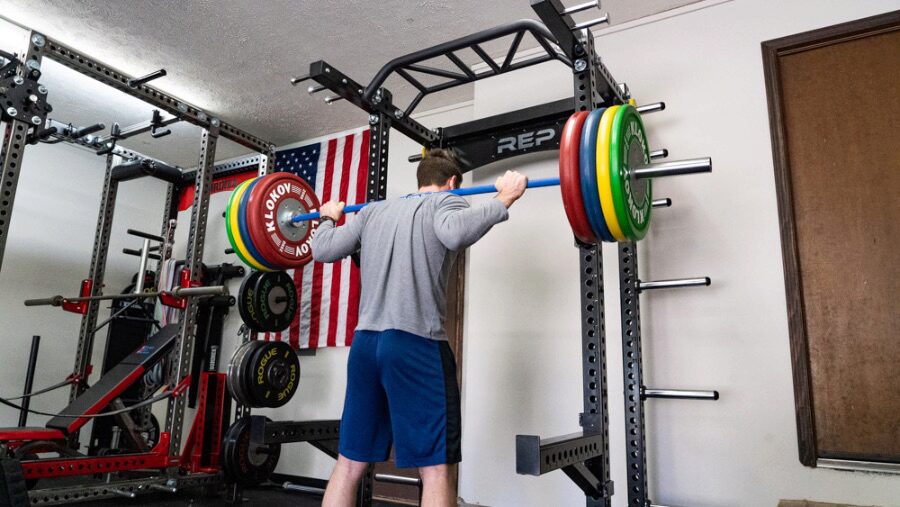We test and review fitness products based on an independent, multi-point methodology. If you use our links to purchase something, we may earn a commission. Read our disclosures.
If you’re going to create a home gym, then you need a squat rack. The squat rack is often the centerpiece of a personal workout space due to its versatility.
If you have a barbell and weight plates in your home gym equipment arsenal, then you can perform a multitude of squat rack exercises. If you add resistance bands to the equation, then the potential for your home gym is even greater, and you can get a full-body squat rack workout.
Benefits of Using a Squat Rack
There are many reasons to incorporate a squat rack into your strength training routine.
Safety
Squat racks have safety arms or safety pins that can serve as protection should you struggle with an exercise and need to release the weight without risking injury or getting stuck. Also, it’s more efficient and potentially safer to do a barbell squat out of a squat rack, as opposed to lifting it and placing it on your back.
Adjustable
You can position a squat rack to fit your size. The J-cups, which hold the barbell, are nearly always adjustable, which means you can set them in different places to perform a wide variety of movements.
Versatile
Lifters who focus on bodybuilding, powerlifting, CrossFit, and Olympic weightlifting would be wise to have a rack. It may be the most important piece of equipment you purchase. You can train all the major muscle groups without taking too much time moving from one station to another or having to make a bunch of adjustments before the next exercise.
10 Squat Rack Exercises
To show how beneficial a squat rack can be, we have 10 exercises that can be used to train all the major muscle groups. All you need besides the rack are a barbell with plates, an adjustable bench (in some cases), and resistance bands.
Squat
Let’s go ahead and get the obvious one out of the way. The back squat is the premiere exercise for the entire lower body, especially the quads. It’s also likely the reason you have a squat rack to begin with. (You can also do front squats and overhead squats with a squat rack.)
How to Do It
- Position the bar so it is just below shoulder height on the rack. The safety arms should be slightly below hip height.
- Step under the bar so you can place the bar on the back of your shoulders. Take a firm grip of the barbell with both hands.
- Stand up with the barbell on your shoulders and step away from the rack so you can position your feet slightly wider than shoulder-width apart. Toes can be pointed straight or slightly out.
- Keeping your core tight and your back as straight as possible, bend your knees and lower your hips until you reach your depth for your range of motion.
- Drive your shoulders and the bar back up to the starting position.
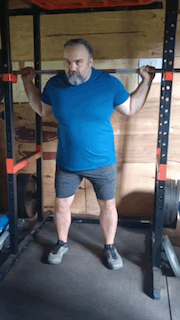
Rack Deadlift
You can work on the top half of the deadlift with this accessory movement. It’s also a good choice for developing the lower back. If strength is a focus, then this exercise should be in your workout routine.
How to Do It
- Position the safety arms of the rack so they are below knee height. Place the barbell on the safety arms.
- With a slight bend in the knee, bend at the hips so the lower back is straight and take an overhand grip of the barbell. If your grip is an issue, use lifting straps.
- Keeping your back as straight as possible, lift the barbell up and bring your hips forward so you’re standing tall with the barbell in your hands. Try to contract your glutes at the top of the movement as well. Lower the bar slowly to the starting position.
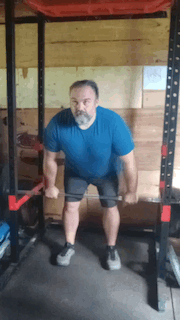
Best Budget Squat Rack
Force USA MyRack Modular Power Rack
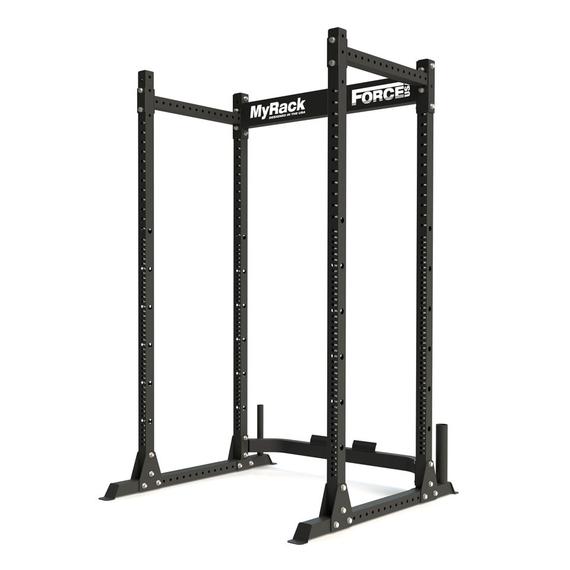
Product Highlights
- Extremely versatile
- Use freestanding or bolted
- 100% customizable
Pros & Cons
Pros
- Modular and extremely versatile
- Performs well after yeas or use
- Easy online buying process
- Price point on the rack is pretty competitive
- Westside hole spacing
- Features a cable crossover attachment.
- Bar storage built-in
- Numbered uprights
Cons
- Thinner uprights with 12-gauge steel
- Attachments use inferior materials
- Powder coat leaves much to be desired
- Numbers on uprights may fade
Bottom Line
The Force USA MyRack is a modular power rack that features every attachment you can think of in a compact rack designed for a home gym. After using and reviewing the rack over the past two years, we stand behind our initial assessment that it's a good option for those that want a rack with a lot of attachments for not a lot of money. It's not the best rack on the market by any means, but it is a novel solution at an affordable price.
Stiff-Legged Deadlift
This is another deadlift variation, but it’s more for your hamstrings and glutes. A full range of motion matters a lot, but starting with the barbell high instead of on the floor makes it easier to perform.
How to Do It
- Connect the J-hooks at knee height so you can lift the barbell outside the squat rack.
- Lift the barbell out of the rack and take a small step forward. Your feet should be shoulder-width apart.
- Push your glutes back while keeping the knees straight, and lower the barbell down as far as you can until you feel a stretch in the hamstrings.
- Slowly return to the starting position and repeat. Once you finish all the reps, step back and return the barbell to the rack.
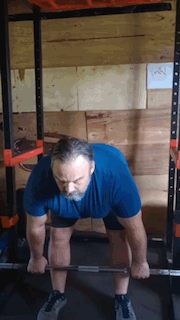
Bench Press
This is the most popular pressing exercise for the chest and triceps, and it works. The description includes a weight bench, but you can actually do them on the floor as well. If you have an adjustable bench, don’t be afraid to try the incline version of this classic lift.
Safety note: It can be dangerous to bench alone. Use a spotter when you can, or learn the correct technique for bailing a bench. Myself, I leave the clips off the bar when benching alone so if I get stuck, I simply rock the bar back and forth until the plates come off.
How to Do It
- Position the bench in the center of the rack. Place the racks so you have to lift the barbell out of the rack to arms’ length over your chest.
- Use a moderate to wide overhand grip when you grab the barbell. Your butt should be on the bench and your feet should be flat on the floor.
- Unrack the barbell slowly until you have it at an arm’s length over your chest.
- Slowly lower the bar until it touches your chest. After a brief pause, press the barbell back up to the starting position. Once you finish your set, slowly return the barbell to the rack.
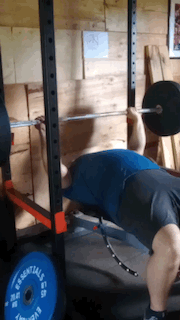
Shoulder Press
An overhead press can be difficult if you have short ceilings, but using a bench and a squat rack offers a seated option that will still help target the front delts. You will notice gains in strength and size with this one.
How to Do It
- Sit on the end of a bench or on a seated bench with a back pad that would be inside the squat rack. You can either place the barbell on the safety arms at shoulder height, or you can have the barbell in the J-hooks on the rack above head level.
- Take the barbell with a wide grip so you can begin the exercise with the barbell at shoulder height.
- Press the bar up until your arms are straight. Slowly lower the bar back to the starting position and repeat.
- When you finish, return the barbell to the safety arms or J-hooks.
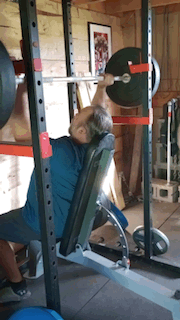
Triceps Extension
You may not have access to a cable machine, but using bands in a squat rack offers you opportunities to perform similar movements. This single-arm version of the cable pressdown will still hit the back of the arms effectively.
How to Do It
- Loop a band around the top of the squat rack and take the other end in the hand of the arm you want to start with.
- Stand so the band goes across the body at the beginning of the movement. You should feel a slight stretch in the band at the beginning of the exercise.
- Pull the band down and straighten your arm, flexing your tricep. Squeeze the tricep hard at the end of this movement.
- Slowly return to the starting position and repeat. When you finish with one arm, repeat with the other.
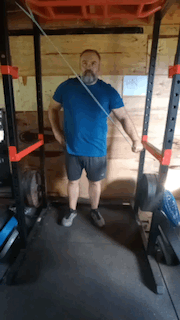
Reverse Hyper
This movement is great for the lower back, but it would be better served in a power rack with four uprights instead of a traditional two-upright squat rack. As long as you observe safety first, then you will have a way to perform a popular exercise without the expensive machine.
How to Do It
- Set the safety arms so they are above hip height. Place two long boards (2 x 6 is a good choice) across the arms, and place a towel or blanket on top of those boards for comfort.
- Place yourself stomach down across the boards so your lower body is hanging off the boards. Your feet should not be able to touch the floor. Hold on to the uprights of the squat rack, and make sure it is weighed down properly.
- Using the strength in your lower back, lift your legs up as high as you safely can. Slowly lower them back to the starting position and repeat. You can use ankle weights for extra resistance if you feel it is necessary.
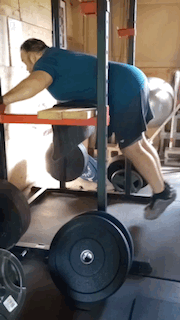
Bent-Over Row
If you want an exercise to help increase power and thickness in the upper back, look no further. The bent-over row will help you work the entire back from top to bottom and side to side.
How to Do It
- Place the barbell on the safety arms of the rack, which should be below knee level.
- Approach the barbell and use a double-overhand or double-underhand grip at a wide grip. Don’t use a mixed grip.
- Stand tall with the barbell, then push your hips back so you bend forward. The bar should approach the rack, but it doesn’t have to touch.
- Pull the barbell up into your stomach or rib cage by driving your elbows back as far as you can. Squeeze the upper back when you do this.
- Slowly lower to the starting position and repeat.
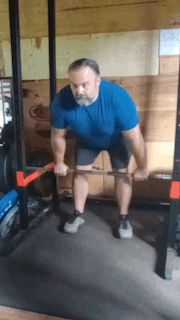
Single-Arm Lat Pulldown
If you don’t have access to pull-up handles, don’t get down. You can use those resistance bands to perform this alternative that will target the lats and upper back muscles. You can do this with one arm or both at the same time. The description below focuses on each side individually.
How to Do It
- Loop one end of a resistance band around the top of the squat rack and take the other in the hand of the side you want to work with.
- Take a knee or sit on both knees on the floor inside the rack so you feel a stretch in the band while you’re holding it. Your arm should be up as if you’re about to perform a lat pull on a machine.
- Using your upper back, pull the band down to your side as far as you can. The band should stretch while you do this. Squeeze the upper back before slowly returning to the starting position.
- Once you finish the reps on one side, switch sides and perform the exercise in the same manner.
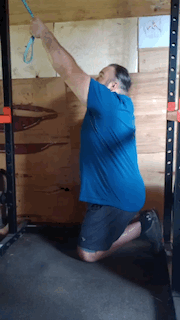
Banded Biceps Curl
This will be the only time that someone suggests doing bicep curls in a squat rack. The band curl can offer you a way to perform single side curls if you don’t have dumbbells. You can perform the normal version as described, or you can hold the end of the band with a neutral grip and do them hammer-style.
How to Do It
- Loop the end of a resistance band around the bottom of the squat rack. Hold the other end in the hand of the working arm.
- Stand far enough back that you feel a slight stretch in the band. Keep the working arm to your side. The other hand can be down to the side or on your hip.
- Curl the band up as you would a dumbbell, flexing your bicep while doing so. Once you finish the curl, slowly return to the starting position and repeat. Repeat the same motion for the other arm as well.
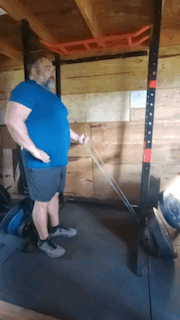
Other Squat Rack Exercises
While the above exercises are some of our favorites, there are many more exercises you can perform with a squat rack:
- Good mornings
- Barbell lunges
- Barbell shrug
- JM Presses
- Split squats
- Pull-ups
Best Barbell
Rogue Ohio Bar
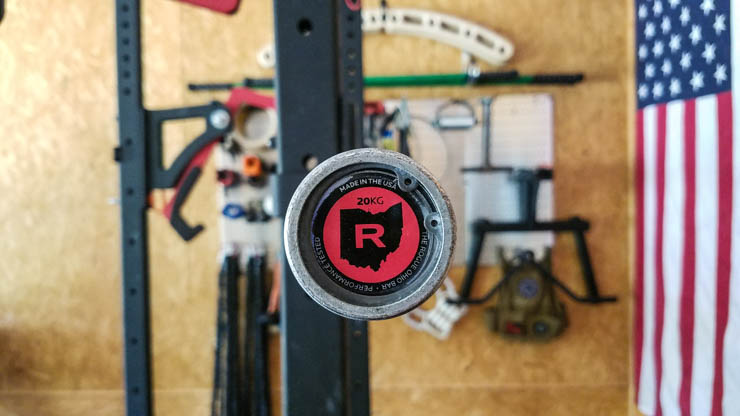
Product Highlights
- 190K PSI tensile strength
- Multipurpose bar with great versatility
- Lifetime warranty
- Bushing sleeves
- Snap ring design
Pros & Cons
Pros
- Made in the USA of US-Sourced Steel
- Somewhat passive knurling
- Grips with chalk
- Great for a variety of training styles
- Dual knurl marks
- 28.5-mm shaft
- Bronze bushings
- Lifetime warranty
- Coatings include stainless steel, Cerakote, black zinc, and more.
- 190K tensile strength
Cons
- Not outstanding for powerlifting or weightlifting in comparison to more specialized bars
- Expensive
- Diameter doesn't meet IWF standards
- No center knurl, which may matter to some
Bottom Line
The Rogue Ohio Bar is one of the most iconic barbells in the world. It's been used at the CrossFit Games by some of the fittest athletes in the world and is just as well suited in your garage gym. The Ohio Bar is priced well despite its features and being made in the USA. Although we prefer the Rogue 2.0 Bar for its price, we don't blame you if you decide to spring for the Ohio Bar, although we'd suggest getting the Stainless Steel or Cerakote version.
FAQs About Squat Rack Exercises
What exercises can I do in a power rack?
The answer to that question depends on the type of rack you have and the equipment you have access to. If you have a rack with a barbell, plates, and resistance bands, then there are literally dozens of exercises you can do that will train the upper body, lower body, and even the core.
We suggest the following:
– Back squat
– Overhead squat
– Front squat
– Bench press
– Rack deadlifts
– Barbell lunges
– Pull-ups
– Banded curls and extensions
– Reverse hyper
– Bent over rows
Can you do dips on a squat rack?
Some squat racks sell dip attachments separately so you can do them inside the rack. If you have a rack that is big enough for you to use two barbells that will fit on the safety arms with you in between them, then it’s possible. However, this isn’t the most effective way to perform dips. It would work until you get a dip station, which is the best choice.
How high should a squat rack be?
If you’re going to use the squat rack in your home, then you need to measure your ceiling to ensure that the rack will have plenty of clearance. If your rack will have a pull-up attachment, then you need to make sure you can perform the exercise so your head doesn’t hit the ceiling.
If the squat rack will be used outside, then you don’t need to be concerned with the height. Most racks are sold in ranges of 78 to 92 inches.
What is the difference between a squat rack and a power rack?
Squat racks have two uprights and are usually connected by a crossbeam. Sometimes those crossbeams have pull-up handles as well. A power rack will have four uprights, and the safety arms will connect at two points instead of one. They are traditionally stronger than squat racks, and you would be able to use more weight. However, they do also take up more room.
Further reading

Our Evlution Nutrition BCAA Energy review covers ingredients, taste, benefits, price, and more to help you decide if this is the right supplement for you. Read more

Do massage guns work? Here’s what the experts say about how they can help with muscle recovery, pain, and mobility. Read more

Our Woodway Curve treadmill review will let you know whether this $5,000+ manual treadmill is worth the investment. Read more

Strengthening the serratus anterior can prevent shoulder injuries. We go over our favorite serratus anterior exercises as well as how to correctly do each one. Read more

